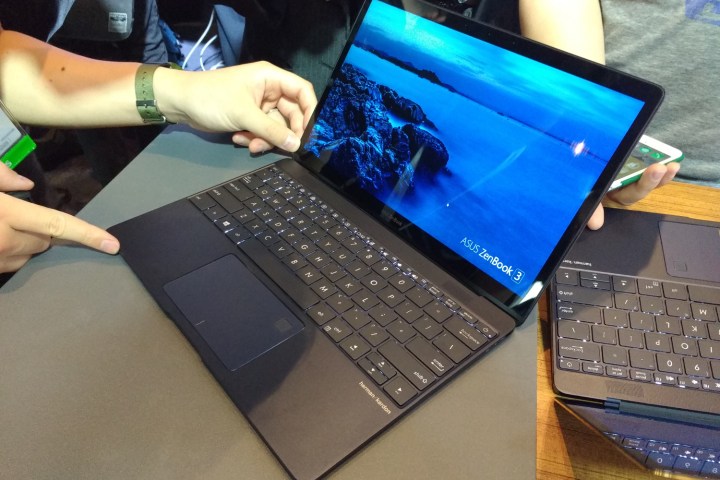
The seventh-generation Intel processors in question are the Core i7-7500U, the Core i5-7200U, and the Core i3-7100U. Here are the specs of each:
| Core i7-7500U | Core i5-7200U | Core i3-7100U | |
| Process node: | 14nm | 14nm | 14nm |
| Number of cores: | 2 | 2 | 2 |
| Number of threads: | 4 | 4 | 4 |
| Base speed: | 2.70GHz | 2.50GHz | 2.40GHz |
| Boost speed: | 3.50GHz | 3.10GHz | N/A |
| Cache: | 4MB | 3MB | 3MB |
| TDP: | 15 watts | 15 watts | 15 watts |
| Max memory support: | 32GB | 32GB | 32GB |
| Processor graphics: | Intel HD Graphics 620 | Intel HD Graphics 620 | Intel HD Graphics 620 |
| Graphics base speed: | 300MHz | 300MHz | 300MHz |
| Graphics max speed: | 1.05GHz | 1.00GHz | 1.00GHz |
These three “Kaby Lake” ZenBooks join current models with older sixth-generation “Skylake” processors consisting of the Core i7-6500U, the Core i5-6200U, and the Core i3-6100U chips. These include Intel’s HD Graphics 520 component, and provide base clock speeds between 2.50GHz and 2.30GHz. This trio of processors launched in the third quarter of 2015 whereas the new processors are fresh off the conveyor belt.
As for Nvidia’s graphics chip installed the UX310UQ model, the GeForce 940M is low on Nvidia’s laptop GPU totem pole, even more so now that the company can shove its GeForce GTX 10 Series graphics chips into laptop form factors. The GeForce 940M sits between the 930MX and the 940MX sporting the following specs:
| Release date: | February 2015 |
| Core name: | GM108 |
| Architecture: | Maxwell |
| Process node: | 28nm |
| CUDA cores: | 384 |
| Texture mapping units: | 24 |
| Render output units: | 8 |
| Base clock speed: | 1,072MHz |
| Maximum clock speed: | 1,176MHz |
| On-board memory: | 2GB DDR3 |
| Memory frequency: | 2,000MHz |
| Memory bus: | 64-bit |
| Memory bandwidth: | 16GB per second |
Now here is an additional list of specs for the two new ZenBook devices, showing the hardware options made available to the UX310 models:
| Operating system: | Windows 10 Home Windows 10 Pro |
| Processor: | Core i7-7500U / 6500U Core i5-7200U / 6200U Core i3-7100U / 6100U |
| Memory: | 4GB DDR4 @ 2,133MHz Supports up to 16GB in a single SO_DIMM socket |
| Display: | 13.3 inches, 3,200 x 1,800 @ 60Hz 13.3 inches, 1,920 x 1,080 @ 60Hz |
| Storage (5,200RPM hard drives): | 500GB and 1TB |
| Graphics: | Intel HD Graphics 520 / 620 |
| Discreet graphics (UX310UQ only): | GeForce 940M with 2GB GDDR3 |
| Storage (SATA 3 M.2 solid state drives): | 128GB, 256GB, and 512GB |
| Keyboard: | Chicklet keyboard Illuminated chiclet keyboard |
| Webcam: | HD Webcam |
| Networking: | Wireless AC |
| Battery: | 3 cells 48 watt-hours |
| Ports: | 1x SD card reader 1x Microphone/headphone combo jack 1x USB 3.1 Type-C 1x USB 3.0 2x USB 2.0 1x HDMI |
| Size: | 12.7 x 8.8 x 0.7 inches |
| Weight: | 3.1 pounds |
As always, customers will see a mixture of these hardware components in set configurations, as Asus doesn’t have a tool for customers to configure their own setup. Right now, Asus doesn’t provide pricing for residents in the United States, but there are variants of each beginning to appear overseas packing the new seventh-generation processors, such as the UX310UQ-FC396T costing around $1,357 in the United States.


